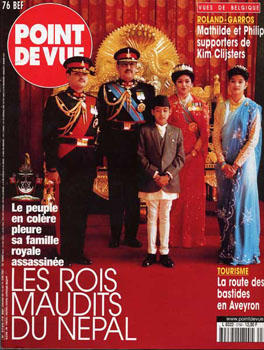|
|
 Inv.
SDE/cn-63211 Inv.
SDE/cn-63211
Nepalese Collection
Item acquired by Nicolas
Stevens for the Surnateum in
Origin: Katmandu (Nepal)
Description:
A complete and extremely rare example of a Nepalese shaman's basket,
containing a strange mummified hand reminiscent of a yeti paw; a drum and
part of an outfit.
Report: Legends
According to an ancient Nepalese legend, King Prithvi
Narayan, while travelling through Katmandu valley, met a wise old man,
whose lined face was actually a disguise for the god Gorakh
Nath. The king offered him some curds, which the old man accepted
but then promptly regurgitated and offered back to the king. Prithvi Narayan
turned the bowl over with disgust and some of the curds splashed onto
the god's feet. Mad with rage, the ill-tempered god Gorakh Nath cursed the king,
telling him his descendants would disappear after the tenth
generation, i.e. the number of years corresponding to the number of
dirtied toes.
But since that is not where the legend actually starts, let's go back
a few more years.
In the 18th century, Prithvi Narayan Shah, who had set out on an
expedition to explore the outermost bounds of his kingdom of Ghorka, met
hunters who had captured an 'abominable snowman'. The creature was in a
pitiful state. The king bought the yeti
and had it cared for as best he could, but unfortunately it was too
late; the creature was dying. The abominable snowman informed Shah
that it was one of the last descendants of its race and that after its
imminent death its body should be carefully hidden away.
It said that Shah's compassion would lead to him being named king
of all of Nepal, as long as the royal family had possession of the
creature's mortal remains. This prophecy was confirmed later by the Brahmans,
even though in 1743, Prithvi Narayan was just one of countless petty Rajput kings
established around 100 kilometres to the west of Katmandu.
In 1766, Prithvi Narayan Shah seized the citadel of Kirtipur,
which commanded the valley of Katmandu. He then had the noses and lips
cut off of all the inhabitants and sent these 'death's head' men and
women out to sow terror throughout the valley.
On 26 September 1768, Prithvi Narayan entered Katmandu on the day of
the festival of Indra Jatra and was named King of Nepal at the age of 45.
Throughout the following decades, the history of Nepalese royalty
resembles a violent game of intrigue and massacre, but the dynasty
remained in place.
In or around 1905, archaeologist Sylvain Lévi - who
had approached the reigning monarch (at that time confined in his
palace "with the women and flowers") - told the then Collector the curious
legend of the abominable snowman. He emphasised that possessing a relic of the creature would enable the owner to
justify his claim to the Nepalese throne. At that time, the 'Ranas' from
the family of Jung Banadur (prime minister and a notorious usurper) held power,
not the Nepalese sovereigns.
They did not possess the relic that would allow them to be rid of Prithvi Narayan's
descendants once and for all.
In 1924, a rumour swept through the scientific community that a
Franco-Prussian archaeologist had brought back a yeti skeleton from Tibet.
In the first volume of his book entitled Sur la piste des bêtes
ignorées (On the track of unknown animals), published
in 1955, cryptozoologist Bernard
Heuvelmans reported a number of similar accounts of creatures
living in the forests of Nepal. These accounts came from Tibet, Nepal, Sikkim
and Bhutan..
It might have all stopped there, as nothing more than legends and
anecdotes - if it had not been for something else...
The expedition
It all began with an e-mail from the Surnateum's Nepalese
correspondent telling us of the discovery of a shaman kit containing
a curious amulet in the shape of a giant hand - probably a yeti paw.
Unfortunately, according to legend, only the king of Nepal can have
access to this type of object, the absolute symbol of royalty.
Possession of this 'amulet' means power. The message
also told us that various groups were looking for the object and that
they posed a genuine threat to anyone trying to get their hands on it.
Killers hired by a member of the royal family, as well as followers of a
Maoist group were competing with our team. The race was on.
Nicolas Stevens volunteered for the expedition. He had the brilliant
idea of concealing the real purpose of his trip in the guise of a hiking
holiday. He would
travel with his twin brother to create a red herring and was sure that he could
find a way to cross the border with the relic.
July 1999: The mission is in Katmandu and our Investigator must
find an excuse to leave the group for three days in order to go looking
for the
shaman's basket. Conveniently, he succumbed to a bad bout of emphysema and was confined to the
town and given medication while the others left on their first trek.
A meeting was arranged with the museum's Nepalese correspondent, who
guided Nicolas through the squalid, stinking alleys of the town near Pashupatinath,
and showed him the basket and the full array of shaman kit. The giant
paw attached to the stick reminded him of the discovery made by
Humboldt-Fonteyne
in March 1924 at the sanctuary of Tasi-Cho-Songny in Tibet, which he
called Eanthropus nivalensis. (The skeleton brought
back by Humboldt-Fonteyne can now be found in a Belgian museum.) The trader explained
in broken English that he preferred to sell to foreigners, because they
paid better, than to members of a given sect or to visionary who wanted
to ascend to the Cobra Throne - especially since if the relic fell into the
wrong hands it could tip the country into anarchy. He was also keen to
keep his head where it was for the time being, since he had a large
family to feed and so on. The talks went on for four hours and finally Nicolas
acquired the item. The next problem was how to get the object through
customs. So, our intrepid explorer visited the customs clearance office, where he
was told that taking these objects out of the country was strictly
forbidden.
The customs officer would only let a tiny part of the acquired objects
across the border. Nicolas knew that he had been identified by the
customs agent. Leaving the office he noticed a young boy following him
to his hotel.
He tried to shake him off using the techniques taught to the Surnateum's
Investigators, but he was not sure that he succeeded.
In the meantime, the rest of the expedition - unaware of
the secret mission - had returned to the hotel. Nicolas' brother said
he wanted to go on a trek on his own into a safe part of the country. He
ended up being attacked by Nepalese bandits wielding axes and only
escaped with his life by keeping his wits about him and diving into a
ravine. After wandering for two days, and left for dead by his attackers,
he managed to make it back to Katmandu in a pitiful state, having lost
all of his gear. He was taken to the emergency room of the hospital,
where he was saved by a local doctor, and urgently repatriated thanks to
a repatriation insurance policy that he had wisely taken out before
leaving home. The carefully wrapped package made it
across the border without being opened.
Conclusion
During the evening of Friday, 1 June 2001, the entire royal family of Nepal
was wiped out and Gyanendra, the king's brother, came to power in Nepal.
King Birendra was the eleventh descendant of Prithvi Narayan Shah. The
king's brother was politely compared to Adolf Hitler by the people. The
prophecy had been fulfilled. The god Gorakh Nath was finally able to
revel in his vengeance and Nepal is teetering on the brink of anarchy.

|
|










